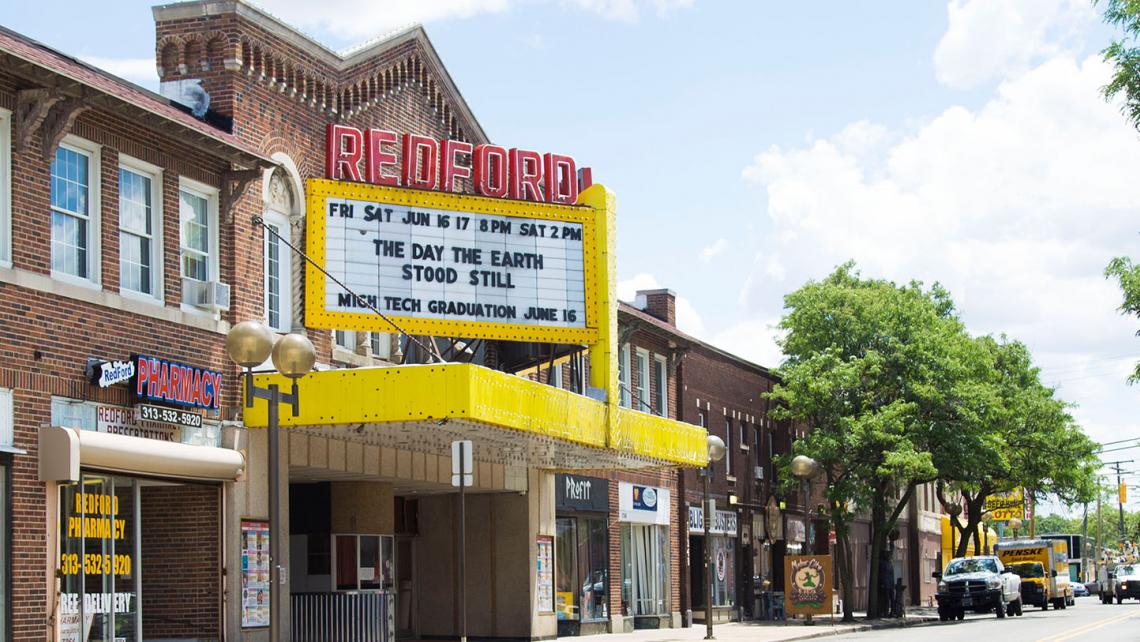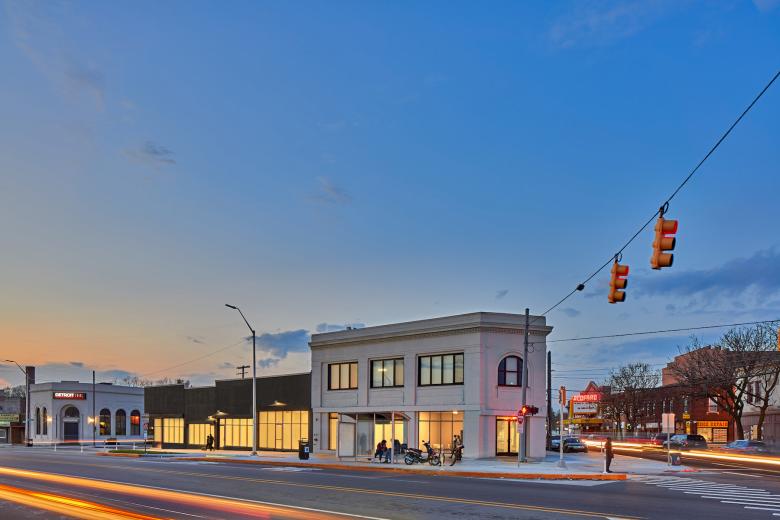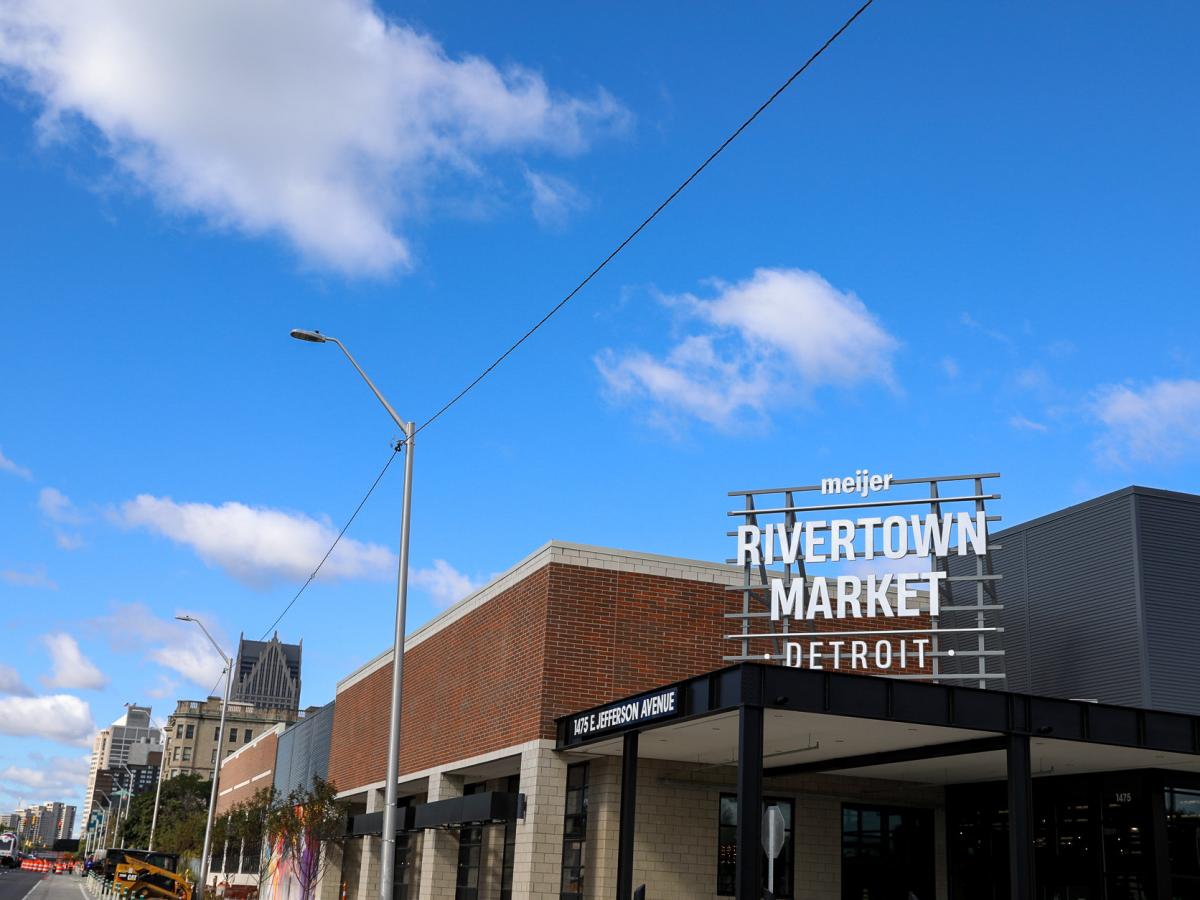Quote:
Originally Posted by Steely Dan

Anyway, here's a map I found online of Chicago's L system superimposed on Detroit.

Source: https://detroitography.com/2014/01/1...ransit-routes/
Had such a a legacy rail transit system been in place, would that have been the difference maker between Detroit's household numbers remaining more or less steady since 1950 vs. the 50% drop in households that did happen? |
Very cool overlay, detroitography does great work. Over all if Detroit had such a rail system elevated, subway and or a mixture of the two built approximately in that way the city likely would have still lost some population but it would be a million plus city easy. I would make a couple tweaks such as the orange line stopping at Oakman & Grand River as it was a major commercial center. The green line continuing west through the Ford HQ and into Fairline Center / U of M Dearborn & the Dearborn train station. Regular commuter rail could cover Michigan Ave / 94 to the Wayne Truck plant & Metro Airport. The Pink line continuing NW to Northland & into the Southfield central business district would be another small change.
Though discussing suburban connections to secondary office centers if Detroit has a proper transit network is getting ahead of ourselves as development patterns would change. I would still suggest the Woodward line running into central Royal Oak north of 696 so there is an intermodal option for commuter rail to Birmingham/Troy & Pontiac.
Detroit would still suffer from automotive decline however just as the white collar related sectors survived and thrived during times of good business a strong heavy rail system anchoring people & businesses to their neighborhoods in mid-century Detroit would have kept key economic sectors in the city as happened in other large cities that saw deindustrialization. The big difference between Detroit and the others is the loss of its mass-transit system just at the time when industrial growth began to slow down.
Mid-century Detroit was one of the top financial centers in the country after New York and Chicago & San Francisco. There’s still a strong financial sector in the region but it’s mostly related to auto financing as opposed to auto financing being one part of a greater financial industry as it used to be. Downtown Detroit keeping its place as the financial center of the region would be a strong indicator that after a transit system holding the city’s neighborhoods together through the hard times there would be potential for a 80’s boom to start an early revival. New York and Chicago while much bigger cities had a big portion of their 80’s revival driven by finance. Detroit would likely lose some inner city population during the late 20th century and lose ground to sunbelt and western cities yet it would have a lot of strong assets to rebuild from as the far end of the 20th century saw.
Imo the city and region would be larger and better organized no question with that kind of transit system in place.
Quote:
Originally Posted by benp

I agree with your observations. As I do not know all of Detroit very well, I really expected that there would be more "hidden" neighborhood commercial districts that I wasn't aware of, so it was very sobering and disappointing to look through the above list of neighborhoods and realize that that's all there are, and not much at that for many of them.
At least the commercial districts of inner suburbs (Dearborn, Highland Park, Hamtramck) can stand in for some of what's missing in adjacent central Detroit neighborhoods, though technically not part of "Detroit" itself.
|
I’ll quote the artist Black Milk when talking about Detroit / the Metropolitan area.
Quote:
Let's talk about who's the most underestimated
Plus underrated city in this hip-hop game
Let's talk about
I don't know if these industry mofo's overlook us 'cause they might be afraid
They don't know if we get the spot like that
You might not get your spotlight back
For a couple decades
Let's talk about Auburn
A burn
Now it's De-twah's turn
Like Berry Gordy came back
Don't think about
Comparing us to another metropolitan area
Or anywhere on this globe
|
https://m.youtube.com/watch?v=0HY5r_4xrEA
The scene in Detroit was different to say the least coming up as a teen and young adult to say the least. In terms of what Detroit is missing people have always get creative when it comes to having a good time. But yeah outside of the Oakland County Woodward Corridor, Hamtramck & Ann Arbor pickings were slim besides concerts or knowing the right group of people before the revival of the city center.
I would say there are some hidden areas I’ve had some good times in Old Redford back in the day the alley and a covered patio area were turned to a really awesome space with videos playing on screens and light shows. As a matter of fact Detroit is all about hidden areas the blind pig is called the after hours nowadays I’ve been to “respectable” ones in all different areas of the city. Though a developed area more towards the edge of the core tend to be the spot. I went to a spot in northen New Center & one over by the Dequindre cut one the last time I was the mood but I’ve also been to ones in really random areas that looked if not abandoned painted up and padlocked when I walked out in the morning light.
The scene in Old Redford wasn’t like that there has been international artist colony that set up shop in the late 90’s and kept the area active through the recession before the neighborhood west of Lasher became a desirable place to live. There’s a big gap to bridge between Grand River in Farmington & a cool hangout spot like Old Redford & a Grand River in Rosedale that is moving towards a vibrant commercial district.
I picked out some photos and grabbed some locations on Google maps incase you or anyone is interested in checking out some of the changes in commercial Detroit.
Old Redford a book end to downtown Farmington along Grand River between suburb and city it also is at the northern end of Brightmoor which is centered at Lasher & Fenkell (5 mile). A lot of sold urban stock and some beautiful well kept neighborhoods but they border ones that were targeted for blight removal. 2024 is the year Brightmoor on the city’s list of blighted neighborhoods to revitalize.
 https://theneighborhoods.org/neighborhoods/old-redford
https://theneighborhoods.org/neighborhoods/old-redford
 https://thevendry.com/venue/64282/re...tre-detroit-mi
https://thevendry.com/venue/64282/re...tre-detroit-mi
 https://www.world-architects.com/en/...obama-building
https://www.world-architects.com/en/...obama-building
 https://100placesinthed.wordpress.co...etroit/page/3/
https://100placesinthed.wordpress.co...etroit/page/3/
I grabbed some locations along Grand River to highlight the new development centered in North Rosedale Park. It’s south east of Old Redford there’s a big box Meijer development next door so it’s hard to say how things have measured out over all with the addition of proper amenities at the expense of small businesses development. The demolition of the blighted Redford High and addition of new retail development at McNichols & Grand River certainly saved a lot of historic street frontage in Old Redford. Though Platform (the Obama building developer) has yet to fully come through with their plans to redevelopment the NE corner of Lasher and Grand River.
https://maps.app.goo.gl/pds1aoEuuqhcUmav5?g_st=ic
Grand River in North Rosedale reminds me of a suburban downtown on the edge of the Oakland Woodward Corridor, more about the big homes than urbanity but still pretty nice. Though it still needs work to get to where it should be at but I think it’s on its way to greater density.
https://maps.app.goo.gl/j6SA7cEyCbLssK849?g_st=ic
https://maps.app.goo.gl/XNH6Tm3dJBGRwfit7?g_st=ic
New apartments
https://maps.app.goo.gl/gSyKxbMTa6XgCX1d7?g_st=ic
Glimpse of North Rosedale Park though the trees
https://maps.app.goo.gl/DBdeXzkxGCrghhvW9?g_st=ic
https://maps.app.goo.gl/AmdkeW3dfyPYXaba8?g_st=ic
https://maps.app.goo.gl/CmJp345nRuY7HCedA?g_st=ic
https://maps.app.goo.gl/mjHoM6F3WPzLhQfa7?g_st=ic
https://maps.app.goo.gl/95Uu7Y1SzpZtknj59?g_st=ic
Outer Drive
https://maps.app.goo.gl/xLuX2i193i7RLxKGA?g_st=ic
https://maps.app.goo.gl/HPMudvohFDmr9Lt48?g_st=ic
https://maps.app.goo.gl/9sYTz1V9g2A91R3H9?g_st=ic
https://maps.app.goo.gl/LDfpgcVFP47UHfZX8?g_st=ic
https://maps.app.goo.gl/pds1aoEuuqhcUmav5?g_st=ic
https://maps.app.goo.gl/pVYqwW6oZWTEqPmXA?g_st=ic
I love Hamtramck my moms family is Polish & they’re place was the get together spot for holidays someone would always get Kielbasa from the source, can’t forget Paczkis either. Cool scene too my girlfriend in college performed at Plant Ant comedy club she got a break with Second City back when it was in Novi & got a spot in Chicago. Had some good times there.
The Oakland Woodward Corridor definitely was and still is providing that critical mass of what Detroit is missing outside of the core. Though as soon as retail started returning to the core there was a big shift in where you wanted to spend your time and get a place. There’s still a scattered nature to life in Detroit the best entertainment is in the city during regular business & bar hours and after hours clubs. The Russell industrial center is another OG small hidden sort of live, work, shop & party space. There have been quite a lot of after hours spots that pop up in popular areas of the city. On one hand I like the informality on the other if you don’t know the organizers or who’s coming which is honestly going to be most of the time you can end up overcharged because some people take they run the place to its natural conclusion.
East Jefferson in the Rivertown / Warehouse district south of Lafayette & Elmwood Parks is probably the closest to reaching that critical mass of having a large urban corridor mostly intact. Known for having a strong nightlife scene, retail has been building up over the past 10 years after being interrupted by the recession. A lot of high-rise & high density living while being in a very attractive location on the water near Bell Isle.
West Village from a few floors up I believe.
 https://www.bridgedetroit.com/consid...s-should-know/
https://www.bridgedetroit.com/consid...s-should-know/
Hidden retail hot spot West Village a part of the greater Indian Village - E Jefferson neighborhood. Van Dyke & Agnes.
https://maps.app.goo.gl/MTQxoG4rJnkGiv818?g_st=ic
https://maps.app.goo.gl/FhLpgh2Tkj7vAetC7?g_st=ic
https://maps.app.goo.gl/iBCBdbuHEe6hPD5y5?g_st=ic
https://maps.app.goo.gl/ZQi67YSGaGqmsw3q8?g_st=ic
https://maps.app.goo.gl/MJQJVaD4FCe925XQ8?g_st=ic
https://maps.app.goo.gl/2hKU7knBWUzNWtZu5?g_st=ic
E Jefferson is hitting that critical mass to support urban (big box) retail with the first Meijers opening in a core urban location in the city vs the suburban outer neighborhoods. If you don’t know of it their rival is Target (aim for a wealthier crowd than Wal-Mart but take what they can get.
Rivertown / Warehouse District & The Parks (Lafayette + Elmwood)
 https://www.rockethomes.com/mi/detroit/condos
https://www.rockethomes.com/mi/detroit/condos
McDougall & E Jefferson. The Meijer near by, a midtown project stalled due to a hotel project stalling during Covid but I won’t be surprised if dense adjacent neighborhoods to downtown have an another period of strong retail growth in the next few years.
https://maps.app.goo.gl/58L7HkDHATfHwUyp6?g_st=ic
 https://detroit.urbanize.city/post/n...east-jefferson
https://detroit.urbanize.city/post/n...east-jefferson
The Michigan Ave corridor in Corktown though Southwest has maintained an old school retail presence on W. Vernor for example and Mexican Town is acting as a center for immigration. W. Warren on the other side of the rail yard is a center for Arab & Middle Eastern immigration. The district is built much more densely than the rest of Detroit outside the core with more apartments & row homes. When Ford’s mobility & R&D campus has time to mature the young professionals along with the immigrants are likely to help this area reach critical mass.
 https://www.forrent.com/find/MI/metr...oit/zips-48216
https://www.forrent.com/find/MI/metr...oit/zips-48216
W Vernor - Springwells
https://maps.app.goo.gl/VvZpTnBuYdYKjc668?g_st=ic
https://maps.app.goo.gl/r4DFHDNDGRyKHqNk9?g_st=ic
https://maps.app.goo.gl/wQhRmz5JXVoRaQoD7?g_st=ic
https://maps.app.goo.gl/PqfbWNTBvYQp1Ecs6?g_st=ic
https://maps.app.goo.gl/yi9idc5GzoKJUGSZ7?g_st=ic
https://maps.app.goo.gl/S38QQNBgESRaA2HF6?g_st=ic
https://maps.app.goo.gl/8kmmJv3LJiq6mnWP7?g_st=ic
https://maps.app.goo.gl/5pZqqDjjYhF4TJdcA?g_st=ic
https://maps.app.goo.gl/u9vRbQ4U9GGND4H59?g_st=ic
https://maps.app.goo.gl/KLy7AjfN5XGCAkvaA?g_st=ic
https://maps.app.goo.gl/dmXHThCReBSX1FrX9?g_st=ic
https://maps.app.goo.gl/fPKP43dyUtLCKXN88?g_st=ic
https://maps.app.goo.gl/7Qfdz9v3HYCWUMWu8?g_st=ic
https://maps.app.goo.gl/ViNkAfdzStt1Wkd9A?g_st=ic
https://maps.app.goo.gl/JpEsMM4aoPqMhWbHA?g_st=ic
Entering Mexican Town
https://maps.app.goo.gl/nuJhaTcBh5rcLJXh9?g_st=ic
https://maps.app.goo.gl/MtFhgRZUVco4VNm49?g_st=ic
https://maps.app.goo.gl/FejhQD5FgSoi8Bos6?g_st=ic
https://maps.app.goo.gl/EJLReGEyi3zbEJA28?g_st=ic
https://maps.app.goo.gl/VusyGEUCPCoyacTU6?g_st=ic
https://maps.app.goo.gl/sUEznXChxw4YebWr7?g_st=ic
https://maps.app.goo.gl/wayFG5VH2WceXrGp7?g_st=ic
https://maps.app.goo.gl/CFfkSLKXBUxUKM7n6?g_st=ic
The center of Mexican Town it was like Greektown 20 years ago a couple blocks. The growth of the Mexican, Middle Eastern & Bengali communities have helped keep Detroit alive during the struggles with the bankruptcy. Mexican immigration has been a big reason SW Detroit has been the consistently growing outer neighborhood.
https://maps.app.goo.gl/xd2Ln8z6t79ADzTJ6?g_st=ic
https://maps.app.goo.gl/xyFdw6UUJJmqZGv78?g_st=ic
https://maps.app.goo.gl/ESdgquRkwMSLmz1Z7?g_st=ic
Though I believe that the Mack & E. Warren Corridor from Morningside through East English Village and particularly Cornerstone is perhaps just as close to becoming a truly well rounded neighborhood. Ie its retail corridors will become a truly healthy and vibrant one similar to Livernois between 8 mile and south of U of D. North Mack is Detroit South Mack is Grosse Pointe until Moross it’s a very nice street with vibrant retail & unique destinations such as the only Feather Bowling (and a bar) the only one in the US, a remnant the neighborhoods Belgian heritage.
There’s less contiguous street front retail on the Detroit side, though I could imagine that in the coming years parking lots will be removed or downsized to accommodate street front businesses. The area actually has been a later to stabilize neighborhood despite how the street would fit in most nice suburbs. The area saw its white population leave late so a generational and class change hit near the Great Recession. The area wasn’t an interest to people looking to move in because the black middle class that moved in were being victimized by crime that came with drugs. The area has had distressed blocks cleaned up and homes put through the land bank. But the majority of the area has high quality housing stock with a lot that has always been well kept with investment coming into as well.
https://maps.app.goo.gl/S2GmqUT5Ew3rA7Rq9?g_st=ic
https://maps.app.goo.gl/4s5fSpYWikzchqqH8?g_st=ic
https://maps.app.goo.gl/ebTC89oBDFGfkXSK8?g_st=ic
https://maps.app.goo.gl/TKLoLCNrYkodpaGX6?g_st=ic
 https://maps.app.goo.gl/qRw2ye7n7ASRhzGp9?g_st=ic
https://maps.app.goo.gl/SCKWbFj4rp9FN4CSA?g_st=ic
https://maps.app.goo.gl/qRw2ye7n7ASRhzGp9?g_st=ic
https://maps.app.goo.gl/SCKWbFj4rp9FN4CSA?g_st=ic
While Grosse Pointe and Detroit have a famously bad relationship on the border of Jefferson Chalmers, Fox Creek neighborhood the residential section was an older neighborhood and built around a factory that closed. The infamous shots of the Alter Rd divide are from here, to the south there is a waterfront neighborhood called “The Canals” which as it sounds is Detroit’s “venice” a popular bootleger home. The abundance of homes with waterfront access and boat garages has kept a strong neighborhood south of Jefferson despite the vacancy to the north. Its central business district Jefferson - Chalmers is getting the works when it comes to redevelopment hoping to attract Grosse Pointe businesses and shoppers but also the local community. The Gold Coast and Berry Subdivision which houses the mayoral mansion is near by across from Bell Isle. It’s an interesting place to watch over the next 5-10 years, I visited a friend in a loft last year it was pretty nice.
One of the main blocks. Jefferson - Chalmers sits between the Gold Coast & Grosse Pointe on Jefferson Ave.
 https://www.jeffersoneast.org/our-neighborhoods
https://www.jeffersoneast.org/our-neighborhoods
 https://www.priceypads.com/1923-bric...roit-michigan/
https://www.priceypads.com/1923-bric...roit-michigan/
 https://www.priceypads.com/1923-bric...roit-michigan/
https://www.priceypads.com/1923-bric...roit-michigan/




